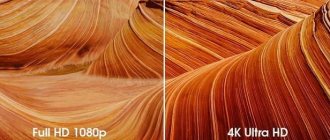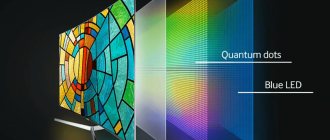photo: oled or led
Smartphone screens achieve incredible levels of sharpness thanks to increased resolutions and better pixel density per inch. And a reasonable question arises: OLED or LED, which is better? Let's look at two types of displays for monitors, TVs, mobile phones, cameras and other devices with a screen.
LED is the most common type of display on the market and is present in all types of technologies. However, it may not be familiar to you because there is a little confusion with the markings on the LCD display. For display purposes, both are the same.
If you see a TV or smartphone that claims to have an “LED” screen, it is actually an LCD display. The LED part only refers to the light source, not the display itself.
There's OLED (organic light-emitting diode) which is used in high-end flagship phones like the iPhone X and iPhone XS.
These are two different technologies. Some say OLED is the future, but is it really that much better than a good LCD? We'll cover how the two display technologies differ, what they're good for, and how they work.
Gadget lovers will be interested in a license-free walkie-talkie, which is intended for temporary use.
OLED vs LED LCD - How are they different?
In a nutshell, LED LCD screens use light to illuminate their pixels, while OLED pixels actually emit their own light. OLED pixels are "emissive" while LCD technology is "transmitting".
The backlight of the OLED display can be controlled pixel by pixel. This kind of dexterity is simply not possible with an LED LCD display, but there are downsides.
In cheaper LCD TVs and phones, LED LCD displays tend to use "edge lighting," where the LEDs are actually placed to the side of the display rather than behind it. The light from these LEDs is then passed through a matrix, which passes it through the red, green and blue pixels into our eyes.
Features of OLED TVs
What is OLED? Organic light-emitting diode is the name of a new type of LED. The technology is based on the use of the conductive ability of certain organic polymers. Most often, OLED is used in the production of the latest generation of modern TVs.
OLED technology uses a film of organic light-emitting diodes to illuminate the screen. OLED lighting is formed from several layers of organic polymers that can emit light when an electric current is applied to them. The small sizes of individual connections make it possible to create pixel matrices based on them. Since every pixel emits light, there is no need for additional backlighting.
Leave a request and receive a 15% discount on your first repair!
Submit your application
OLED vs LED LCD - Brightness
LED LCD screens are brighter than OLED. This is a big problem for TVs, and even more so for smartphones, which are often used outdoors in bright sunlight.
Brightness is typically measured in “nits”—roughly the light of a candle per square meter. The OLED-equipped iPhone X has a typical peak brightness of 625 nits, while the LCD-equipped LG G7 has 1,000 nits. In the world of television, this goes even further - Samsung QLED TVs can emit over 2,000 nits.
Brightness is important when viewing content in ambient light or sunlight, and for high dynamic range videos. This applies more to TVs, but phones are increasingly boasting video performance, and so it matters in the smartphone market too. The higher the brightness level, the greater the visual impact, which is half a point of HDR.
OLED vs LED LCD - Contrast
Take an LCD screen into a darkened room and you may notice that parts of the pure black image aren't actually black because you can still see the backlight (or edge lighting).
The ability to see unwanted backlight affects a TV's contrast, which expresses the differences between its brightest highlights and darkest shadows. You'll often see the contrast ratio listed on a product's specification sheet, especially when it comes to TVs and monitors. It tells you how much brighter the white color of the display is compared to its black color. A decent LCD screen can have a contrast ratio of 1000:1, meaning the whites are a thousand times brighter than the blacks.
The contrast on an OLED display is much higher. When an OLED screen goes black, its pixels emit no light at all. This means you get an infinite contrast ratio, although how great it is will depend on how bright the LEDs can be when lit.
OLED vs LED LCD - Viewing Angles
OLED panels have excellent viewing angles, primarily because the technology is so thin and the pixels are located so close to the surface. You can watch OLED TV from different places in your room without losing contrast. Viewing angles are especially important for phones because no one holds their hand perfectly parallel to their face.
Viewing angles are generally worse on LCDs, but this greatly depends on the display technology used. And there are many different types of LCD panels.
Perhaps the most basic is the twisted nematic (TN). This type is used in budget computer monitors, cheaper laptops, and some very cheap phones. It offers a poor viewing angle. If you've ever noticed that your computer screen appears shadowy from a certain angle, then it's most likely a warped nematic panel.
Luckily, many LCD devices now use IPS panels. This provides "in-plane switching" and typically provides much better color reproduction and significantly improved viewing angles.
IPS is used in the vast majority of smartphones and tablets, many computer monitors, and many televisions. It's important to note that IPS and LED LCD are not mutually exclusive; it's just another slang question. Beware of the hype game and go straight to the specs.
List of manufacturers using OLED and QLED technologies
Now you know which TV to choose. We examined in detail what is the difference between OLED and QLED. In 2021 and 2021, QLED TVs are sold exclusively under the Samsung brand, since the technology using nanocrystals is a proprietary development of the South Korean company. If we talk about OLED models, such TVs are found from various manufacturers, despite the fact that this technology was developed by LG. This technology is actively used by Japanese brands, for example, Sony.
OLED vs LED LCD - color
The latest LCD screens can produce fantastic natural colors. However, as with viewing angles, this depends on the specific technology used.
IPS and VA (vertical alignment) screens provide high color accuracy when calibrated correctly, while TN screens often appear weak or washed out.
OLED colors have no problem with pop and vibrancy, but early OLED TVs and phones had problems maintaining color and staying realistic. The situation is better these days - Panasonic's FZ952 series OLED TV is even suitable for use in Hollywood color studios.
OLED loses in color volume. That is, truly bright scenes can challenge an OLED panel's ability to maintain color saturation levels. This is a weakness pointed out by manufacturers who prefer LCD.
What is the future for LCD and OLED?
Display manufacturers are doing their best to tweak and improve various LCD display limitations. OLED's goal is to become cheaper and brighter over the next few years, and we're seeing clearer developments in LCD displays.
Perhaps the most memorable is the “quantum dot”. This is a new way to approach LCD backlighting. Instead of using white LEDs, a quantum dot screen uses blue LEDs and "nanocrystals" of different sizes to convert light into different colors by changing its wavelength.
Samsung has been testing quantum dot technology for several years now, and the company's latest developments actually bring LCD (nicknamed QLED) closer to the performance of OLED. Samsung wrapped the nanocrystals in a metal alloy and retuned the lighting system, which eliminates many of the contrast and viewing angle issues associated with LCD panels.
QLED technology
Relatively recently, Samsung presented its flagship line of TVs. Users almost immediately noticed the unfamiliar abbreviation “Quantum Dot SUHD”. Without really giving buyers the opportunity to figure out what is special about this series, the South Korean brand introduces QLED TVs. For the first time, devices created using this technology began to appear on store shelves in 2021.
The manufacturer failed to get rid of associations with OLED. The names are really consonant and quite similar. However, the chosen names fit very harmoniously into the marketing strategies of Samsung and LG. Few people know what the difference is between OLED and QLED, but everyone understands that this is top quality technology.
QLED TVs are based on quantum dot technology. QD is a short term for this method. Samsung's exclusive technology did not involve the use of cadmium. The structure of quantum dots is characterized by the absence of a concentration of organic substances. It is based on microscopic crystals. The diameter of these particles is 2-10 nanometers.
The size of the crystal affects the color of its glow. Using several of these elements allows you to provide a wide range of color palettes. However, quantum dot TVs still use the same well-known LED backlight, but with an additional filter. The special layer is a film on which the crystals are located.
Samsung uses blue LED backlighting rather than traditional white. The addition of film with quantum dots makes the image more colorful and saturated.
An obvious advantage of quantum dots is the minimal level of distortion of the light structure. The key principle of QLED technology is complete control over the size of the dots. Therefore, exactly the shade that is needed is transmitted. The light emitted by the additional backlight filter has maximum saturation and brightness. The manufacturer managed to provide a uniform shade.
For the South Korean brand, QLED technology was a real breakthrough. Even without major intervention and re-equipment of production lines, truly high-quality TV displays can be created. To achieve the desired result, you should simply remove several filter layers that were used previously. They are replaced by layers with particles of miniature crystals.
To simplify, QLED is still the same liquid crystal screen, but in a more innovative interpretation. LED backlighting is still required to broadcast the image. The principle of using quantum dots should not be considered in the context of the evolution of OLED technology. This is a completely new stage in the development of LED backlighting on LCD screens.
Which is better - OLED or LED LCD?
It's a challenge, but LCD is definitely better than OLED in terms of number of digits. LED LCD has been around much longer and is cheaper to produce, giving it an advantage when it comes to market saturation. However, OLED is a great luxury option and OLED technology is gaining momentum. OLED is already much better than LED LCD in terms of darkness and lightness.
If you're on a budget when purchasing a phone, monitor, laptop, or TV, you'll likely get an LCD screen. OLED, meanwhile, remains the more luxurious offering.
But LCD dominance is gradually waning; OLED technology is developing rapidly. The technology is already present in the best smartphones, which has created a big resonance in the television world.
What's better? Even if you take money out of the equation, the choice comes down to personal taste. Neither OLED nor LCD LED are perfect. Some praise OLED's ability to cope with darkness and the precision of its lighting. Others prefer the LCD's ability to get brighter and maintain colors at a vibrant level. Whether you choose LCD or OLED technology has grown significantly, making it a safe investment.
Who will win
The main parameters of all types of display matrices have been reviewed, which means it’s time to answer the most important question - which technology will provide the best quality, and which TV is worth buying? If your budget allows, then give preference to a model with an OLED matrix.
However, if you want to choose a TV with the optimal price/quality ratio, or you are interested in a specific parameter (brightness, color reproduction), then the new 4K TV device from Samsung will look like a preferable option.
If we talk about ordinary 4K LED TVs with HDR support, of which there are much more in electronics supermarkets, then they will also cope with the reproduction of ordinary media content.











